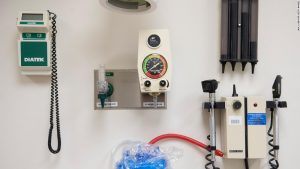It’s evident in the voices of the health care workers who have just come through perhaps the most trying period of their professional lives. It’s visible in the repurposed COVID-19 wards and clear in the data: The coronavirus pandemic as we have experienced it this last year and a half is ending, and Bay Area hospitals, ground zero for the worst of the illness and death, are returning to some semblance of normal.
The number of coronavirus patients has plummeted to single digits at many medical centers as the state chugs toward Tuesday’s reopening. Local hospitals are dismantling or converting triage tents, allowing more visitors and even encouraging weary health care workers to finally take much needed time off.
“We’ve rounded the corner,” said El Camino Health’s chief nursing officer, Cheryl Reinking. “It’s very hopeful.”
On Thursday, the hospital had just three coronavirus patients, a typical number over the last several weeks. During the height of the winter surge, doctors and nurses were scrambling to care for 79 at a time.
Now, one of the Mountain View hospital’s long wings that previously treated only coronavirus patients has been deep cleaned in preparation for an expected COVID-lockdown-inspired baby boom this summer and fall, when it will serve as an overflow area for moms and new babies. And a massive storage space is now overflowing with personal protective gear such as the masks and gowns that were so hard to come by at the start of the pandemic.

At many of Kaiser’s 21 Northern California hospitals, and particularly in the Bay Area where vaccination rates are high and COVID-19 hospitalizations low, medical centers that ran two busy intensive care units have scaled back to one, with fewer people needing ventilators and high-flow oxygen. Traveling nurses brought in to help during the worst of the pandemic have packed up and moved on. Triage tents have been repurposed as vaccination clinics and visitor policies are easing, especially for pediatrics and labor and delivery.
“It’s so inspiring for the staff,” said Stephen Parodi, an infectious disease doctor and associate executive director for The Permanente Medical Group at Kaiser.
Across the 10-county Bay Area, hospitalizations have been in the low 200s since late May, down from a peak of more than 2,400 in early January. Fewer COVID-19 patients hasn’t made for quieter hallways, though.
“The hospital is busier,” said Sanjay Kurani, hospital medical director at Santa Clara Valley Medical Center, in a comment echoed by doctors across the region.
That’s because surgeries are returning to pre-pandemic levels as more people come in for elective procedures that they put off or had canceled when the virus was raging, and even numbers at the emergency department are trending up.

“People just feel safer returning,” Kurani said.
Even with the renewed bustle, hospitals are giving exhausted workers time off when they can. That’s been especially necessary because while hospital workers regularly encounter and expect stress on the job, the stress of the pandemic has followed them home, affecting their families and lives in a way that their usual work does not.
“I think that’s what’s uniquely different in this situation,” Kurani said.
Not everything is getting back to normal, however. As masking requirements lift for much of California next week, they will continue in health care settings. Workers will still screen people entering hospitals, and many facilities are continuing to test patients for the coronavirus before surgery, although some places have scaled that back. How long such practices continue remains to be seen, with hospitals juggling an array of guidance from counties, the state and other regulators.
“We have quite a lot in play right now,” said Adrienne Green, chief medical officer for UCSF Medical Center. And while hospitals gradually move toward pre-pandemic practices, they’re also, Green added, “holding onto some of the things that we learned from the pandemic.”
When the coronavirus hit, Green and other chief medical officers from across San Francisco started meeting to share what they were learning about how to fight the deadly virus. Health workers in counties across the Bay Area did the same. They’re still talking, broadening their conversations to other diseases and illnesses where the work was traditionally more siloed.
“That collaboration will continue I think to the benefit of our whole community,” Green said.
So will virtual doctor visits and other ways of digitally sharing health information and monitoring people remotely — even those requiring intensive care — that exploded during the pandemic.
“There’s a lot to be said for virtual, and there are so many wearable devices” that can transmit health information to health care providers, said William Isenberg, chief quality and safety officer for Sutter Health. “We have a very aggressive innovation team.”
Kaiser is expanding home care, where people can receive hospital-level treatment — things like IV fluids — at home. While such care was often prohibitively expensive just several years ago, technology has evolved, Parodi said, to the point that remote monitoring is possible, and the process of sending supplies and prescriptions to someone can be managed through a tech program.
“I see us only expanding upon that,” Parodi said.
Amid all the buoyancy, many hospital leaders expect to see a few coronavirus patients here and there as the economy reopens and more people gather. Despite the fact that about 65% of Californians 12 and older are at least partially vaccinated, there are still plenty of people who are still vulnerable to the disease. And there is also the possibility of new vaccine-resistant variants of the virus emerging.
“I want us to be cautiously optimistic,” Isenberg said. “We have to be careful.”
Staff photographer Dai Sugano contributed reporting.



















